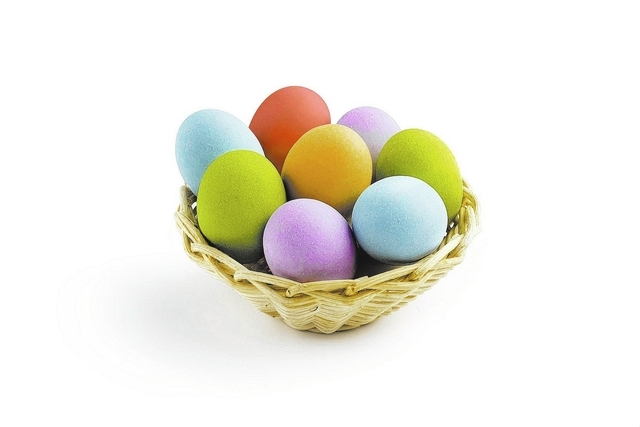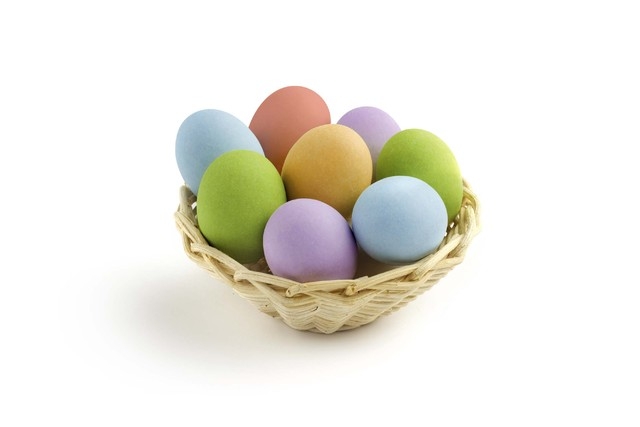Eggs, an Easter tradition, are healthful if eaten in moderation








OK, in the style of one of those game shows, we’ll do a little word association this week:
Easter …
Egg!
Yes, eggs seem almost inextricably linked to Easter, more so, even, than chocolate bunnies and overcooked hams. But this seemingly secular symbol of the holiday is rooted in Christian tradition.
“The origins of it come a little bit from pagan times,” said the Rev. Richard Philiposki, a priest at Our Lady of Las Vegas and the Blessed John II Polish Apostolate. “It’s a spring ritual — nature coming back to life. There’s new life sprouting, as well as the egg symbolizing life.”
And as the early Christians adopted and adapted some pagan traditions, the egg was incorporated into their religion. It became a tradition for Christians, particularly in Eastern Europe, to decorate eggs in various ways and to have them blessed on Holy Saturday along with other Easter foods, Philiposki said. (Our Lady of Las Vegas will have three blessing ceremonies on Saturday, at 11 a.m., noon and 1 p.m.)
Some people decorate their own eggs at home, he said, and some display decorated wooden eggs.
“In our tradition, which is not exclusively Polish but Eastern European, Russian and Ukrainian as well, we call our Easter eggs ‘pysanky,’ ” Philiposki said. “They’re usually painted, and they can be different kinds; some are all in one color. They can be very ornate, using different dyes and things like that.”
In another Eastern European tradition, he said, an egg is sliced into splinters and each person takes a piece, dipping them into horseradish or beet horseradish as they share from the same egg.
“They exchange greetings for a blessed Easter, and celebrate Christ’s resurrection,” he said.
Some celebrants, though, may shy away from eggs because of a perceived health risk. Mary Wilson, a registered dietitian and extension nutrition specialist with University of Nevada Cooperative Extension, said most healthy people don’t have to worry.
“Certainly, over the last 50 years, we really have had some things that eggs weren’t so good,” she said. “But that wasn’t necessarily based on actual science. As long as I’ve been a dietitian — which has been about 30 years — we’ve known that eggs were an excellent and relatively inexpensive source of protein, and that they’re healthful in most peoples’ diets.”
On average, she said, an egg a day is OK for most people.
Egg safety is a factor that should always be remembered. The American Egg Board says eggs should be cooked until the yolks and whites are firm, or 160 degrees, because heat destroys salmonella. When using eggs, be sure to frequently wash your hands, as well as surfaces and utensils that come in contact with raw eggs. Separate eggs from other items in your grocery cart and bags to avoid cross-contamination, the council says, and be sure to keep them refrigerated; eggs left at room temperature for two hours should be discarded, and that drops to one hour when the weather is warm.
Wilson said, however, that eggs last longer in the refrigerator than most people think. The date on an egg carton is not an expiration date, but a pull date.
“Eggs are good at least three to five weeks past that pull date,” she said.
Here are some egg preparation tips from the American Egg Board and McCormick.
To hard-cook an egg: For easier peeling, use eggs that are seven to 10 days old. As an egg ages, it gradually takes in air, which helps separate the membranes from the shell. “Hard-boiled” is a misnomer, what you want to do is “hard-cook” the egg. (The greenish ring that sometimes forms around the yolks of hard-cooked eggs is from a chemical reaction that occurs when eggs are cooked too long or at too high a temperature.) Place eggs in a saucepan large enough to hold them in a single layer. Add cold water to cover eggs by 1 inch. Heat on high just to boiling. Remove from heat. Cover pan. Let eggs stand in hot water for about 12 minutes for large (9 minutes for medium, 15 minutes for extra-large). Drain. Cool under cold running water or in a bowl of ice water and refrigerate.
To peel a hard-cooked egg, tap it on a countertop to crackle the shell; roll between hands to loosen shell. Starting at large end, peel egg while holding under cold running water.
Hard-cooked eggs can be refrigerated safely for as long as a week. Peeled eggs should be eaten within a day.
Here are recipes starring eggs.
FAVORITE DEVILED EGGS
6 hard-cooked eggs, finely chopped
1 teaspoon finely chopped onion
3 bacon strips, cooked and crumbled
½ teaspoon salt, optional
½ teaspoon pepper
¼ teaspoon prepared mustard
¼ cup mayonnaise
1 cup (4 ounces) shredded cheddar cheese
In a large bowl, combine the first seven ingredients until blended.
Shape into 1-inch balls. Roll in cheese. Cover and refrigerate until serving.
Makes 25.
— Recipe from Taste of Home
MUFFIN FRITTATAS
6 eggs
½ cup milk
¼ teaspoon salt
1/8 teaspoon pepper
1 cup (4 ounces) shredded cheddar cheese
¾ cup chopped zucchini
¼ cup chopped red bell pepper
2 tablespoons chopped red onion
Preheat oven to 350 degrees.
Beat eggs, milk, salt and pepper in medium bowl until blended. Add cheese, zucchini, bell pepper and onion; mix well. Spoon evenly into 12 greased muffin cups, about ¼ cup each.
Bake until just set, 20 to 22 minutes. Cool on rack 5 minutes. Remove from cups; serve warm.
Serves 6.
Note: Can be made ahead and refrigerated, then reheated in microwave.
— Recipe from the American Egg Board
MINI ITALIAN BREAKFAST CASSEROLES
4 eggs
3 tablespoons milk
1 tablespoon grated Parmesan cheese (plus additional for serving, if desired)
Dash pepper
1 cup baby spinach, chopped
4 slices ham or 8 thin slices prosciutto (about 4 ounces)
Heat oven to 350 degrees. Whisk eggs, milk, cheese and pepper in medium bowl until blended. Add spinach; stir to mix.
Line four greased 10-ounce ramekins or custard cups with ham, pressing against bottoms and sides. Divide egg mixture among ramekins; place in baking pan.
Bake in center of oven until custard is just set, about 20 minutes. Remove from oven; let stand 5 minutes. Sprinkle with additional cheese, if desired.
Serves 4.
— Recipe adapted from the American Egg Board
EASTER BREAD
8 large eggs (divided use)
Food coloring (optional)
2/3 cup whole milk
5 tablespoons sugar (divided use)
1¾ teaspoons active dry yeast (from one ¼-ounce envelope)
2¾ cups unbleached all-purpose flour, plus extra for dusting
1 teaspoon kosher salt
½ cup (1 stick) unsalted butter, cut into 1-inch pieces, room temperature, plus ½ tablespoon, melted
Place five eggs in a medium pot. Pour in cold water to cover by 1 inch and bring to a boil over medium-high heat. Remove from heat, cover pot and let stand for 10 minutes. Transfer eggs to a medium bowl of ice water; let cool completely.
If desired, color eggs according to food-coloring package directions. Transfer eggs to paper towels to dry. (Eggs can be dyed up to one week ahead. Cover and chill.)
Hold two of the remaining eggs at room temperature.
Heat milk in a small saucepan over medium heat or in a microwave until an instant-read thermometer registers 110 to 115 degrees. Transfer to a 2-cup measuring cup; stir in 1 tablespoon sugar. Sprinkle yeast over milk and whisk to blend. Let sit until yeast is foamy, about 5 minutes. Add the two eggs; whisk until smooth.
Combine remaining 4 tablespoons sugar, flour and salt in the bowl of a stand mixer fitted with a dough hook. Add milk mixture. With mixer running, add ½ cup room-temperature butter, 1 piece at a time, blending well between additions. Mix on medium speed for 1 minute. Knead on medium-high speed until dough is soft and silky, about 5 minutes.
Brush a medium bowl with some melted butter; place dough in bowl. Brush top of dough with remaining melted butter; cover with plastic wrap. (Can be made one day ahead; cover with plastic and chill.) Let dough rise in a warm, draft-free area until doubled in size, 1 to 1½ hours (or 2 to 2½ hours if dough has been refrigerated).
Line a large baking sheet with parchment paper. Punch down dough. Divide into three equal pieces. With lightly floured hands, roll each piece on a lightly floured surface into a 16-inch-long rope with tapered ends. (If dough begins to bounce back, cover with a kitchen towel and let rest for 10 minutes to allow dough to relax.)
Arrange ropes side by side lengthwise on prepared sheet. Pinch top ends together. Braid dough. Pinch bottom ends together to secure (braided loaf will be about 12 inches long). Tuck dyed eggs between braids, spacing evenly. Loosely cover with plastic wrap or a kitchen towel. Let rise in a warm, draft-free area until puffed but not doubled in size, 45 to 50 minutes.
Arrange a rack in middle of oven; preheat to 375 degrees. Whisk remaining egg with 2 teaspoons warm water in a small bowl. Avoiding dyed eggs, brush dough all over with egg wash. Bake until bread is golden and an instant-read thermometer inserted into center of loaf registers 190 degrees, 20-25 minutes. Let cool on a wire rack. Serve warm or at room temperature. (Can be made 8 hours ahead. Let cool completely and store airtight at room temperature). Makes one loaf.
— Recipe from Bon Appetit magazine
EASTER MERINGUE CUPS
3 egg whites
½ teaspoon vanilla extract
¼ teaspoon cream of tartar
¾ cup sugar
½ cup lemon curd
1 cup sliced fresh strawberries
2 medium kiwifruit, peeled and sliced
½ cup fresh raspberries
1/3 cup mandarin oranges
1/3 cup cubed fresh pineapple
Place egg whites in a large bowl; let stand at room temperature for 30 minutes. Beat the egg whites, vanilla and cream of tartar on medium speed until soft peaks form. Gradually beat in sugar, 1 tablespoon at a time, on high until stiff peaks form.
Drop meringue into eight mounds on a parchment paper-lined baking sheet. Shape into 3-inch cups with the back of a spoon. Bake at 275 degrees for 45-50 minutes, or until set and dry. Turn off oven and do not open door; leave meringues in oven for 1 hour.
Spread cups with lemon curd and fill with fruit.
Serves 8.
— Recipe from Taste of Home
NOODLE-CRUSTED DENVER QUICHE
2 cups (4 ounces) uncooked fine egg noodles, cooked and drained
1 tablespoon water
1 cup chopped green bell pepper
3 tablespoons chopped onion
1 cup (4 ounces) chopped cooked ham
6 eggs
1 cup milk
2 teaspoons prepared mustard
Preheat oven to 375 degrees. Press noodles evenly on bottom and sides of greased 9-inch pie plate.
Heat water in large nonstick skillet over medium-high heat until hot. Add bell pepper and onion; cook and stir until water has evaporated and vegetables are crisp-tender, 3 to 4 minutes. Add ham; mix well. Spoon into noodle crust.
Beat eggs, milk and mustard in medium bowl until blended. Carefully pour over ham mixture.
Bake in center of oven until quiche’s center is puffed and knife inserted near center comes out clean, 30 to 40 minutes. Let stand five minutes and cut into wedges.
Serves 6.
— Recipe from the American Egg Board
Contact reporter Heidi Knapp Rinella at hrinella@reviewjournal.com or 702-383-0474.


















